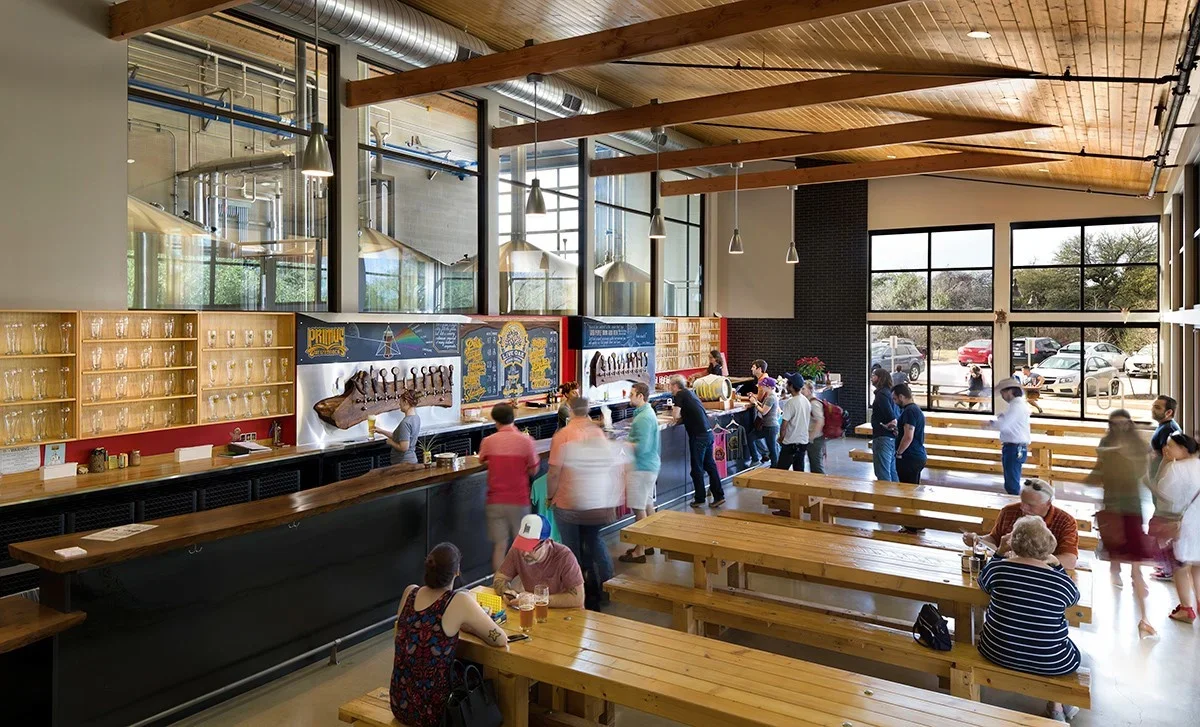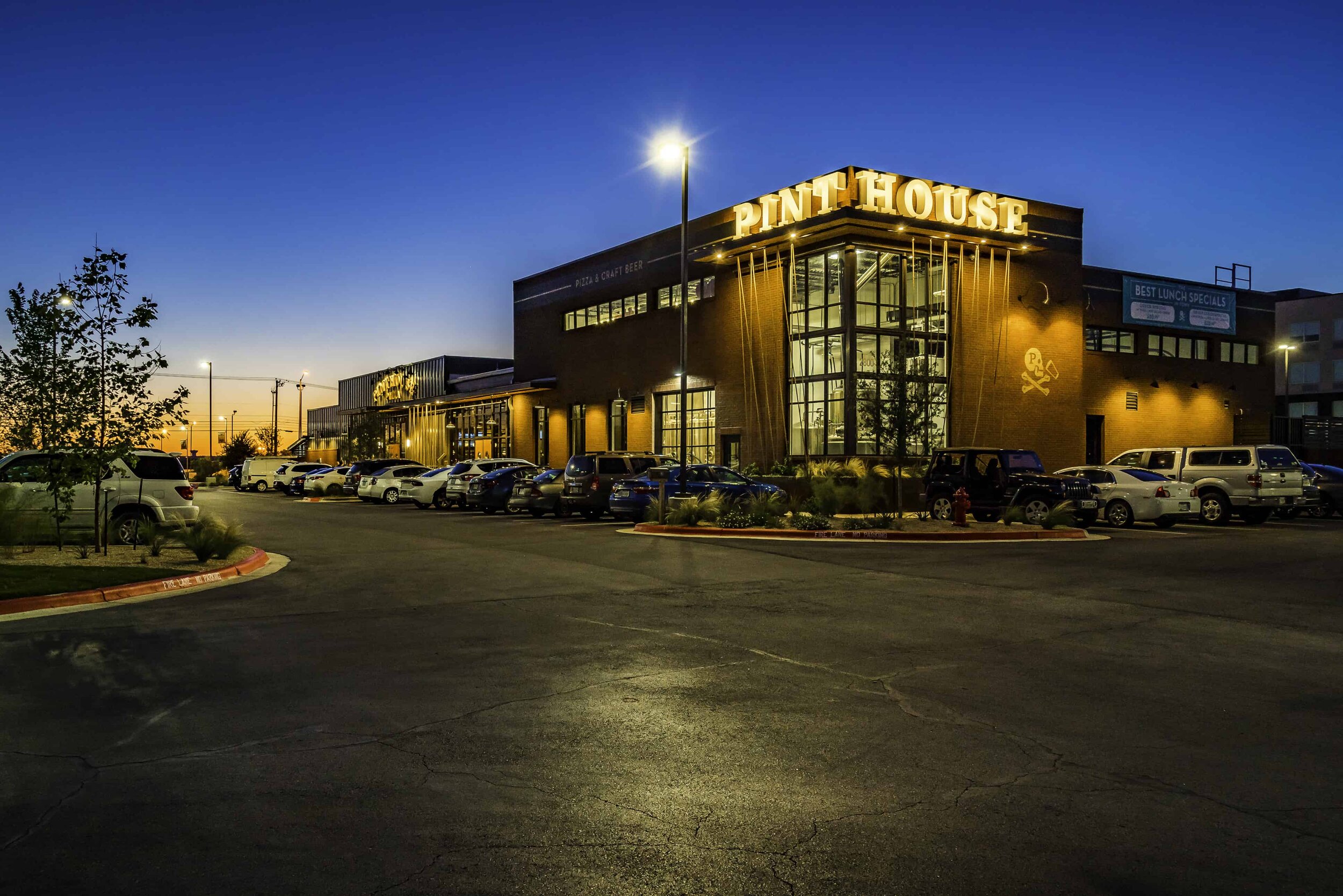Over the last two months and many conversations with both current and former clients, it’s obvious that when craft brewpubs, distilleries, tasting rooms, etc. begin reopening there will be considerable focus on how to best respond responsibly and smartly to the massive upheaval the industry and all of us have felt. There’s much to figure out and we need to do so with an eye on the short-term (now thru 3-6 months), the mid-term (6 months to 2 years) and the long-term (2+ years). The changes come in so many different areas and they are all worth discussion as every facility, whether existing or in the future, will be impacted uniquely.
Here’s a snapshot of the issues and areas we’ve been diving into:
Seating arrangements and types of furniture.
It’s pretty clear that in the short term to mid term there will be both a real and perceived risk to sitting in larger groups. So many tasting rooms have opened with a focus on community tables where both strangers and friends can cram in together. This seating type will likely immediately fall out of favor. All indications are most people will gravitate to a more isolated and protected seating location even after our current occupancy restrictions and social distancing become less necessary. New gathering habits created by the pandemic will become a new normal and having flexibility with our furniture to sit further apart will feel more appropriate. For some tasting rooms this will be an easier transition. Rooms might appear poorly suited as community tables get “spacers” placed on them to encourage the separation of patrons. For others, this may require some rethinking to the overall room configuration all together. Seating arrangements and furniture styles may have been at the core of how the room successfully flowed and operated. Addressing shortfalls in a new arrangement may require changes in service, bussing of tables, queuing and ordering as the room no longer works quite as intended. In addition, the cleanability and sanitation of furniture need to be a major priority. The long-term solution might be a better mix and flexibility to how a room is used. Maybe community tables after a couple years don’t quite fully disappear. They are somewhat iconic to the beer hall. Hopefully we can all look forward to that day returning safely.
Ordering, Self Service, Queuing and Circulation.
This aspect of the COVID19 design response applies to nearly all industries where the public is engaged. There’s already a fair number of retail focused articles out there that are discussing touchless purchasing, limited interaction with service, one-way flow thru a space (to limit people passing each other). Here’s a few that to pass along:
https://www.frameweb.com/news/clean-lines-clean-spaces-covid-19
https://www.retaildive.com/news/the-consumer-after-covid-19/575634/
Signage.
One key change in the short-term in particular is going to involve educating customers on how to use a space differently than they remember. Collectively we will go thru this together as a society where we enter new and old spaces and begin seeing new instructions and reminders. Most of us have seen this already at Grocery Stores and a few other spots that have remained open. As cities ease restrictions at breweries, distilleries, bars, etc. we will have new messaging for spacing in lines, what can and should be touched by the customer, where to put glassware, messages of care/respect/distancing, and a whole set of new rules specific to each activity. This messaging will need to be prominent and visible. It may be on every table, every wall and public door. Over time as we approach the 6 month point, maybe some of these new rules become unnecessary and it starts to fade from view. Hopefully, it’s not the kind of messaging that becomes ignored in its abundance. I would say the odds are high that a good percentage of new health safety signage remains in the public view for at least a couple years. Doing this in a way that works well with the branding of an establishment will be an opportunity to reduce the visual clutter to keep the most important signage clear and easy to follow. This messaging will be critical to both the public and employees to feel aware, yet comfortable and safe.
Air Quality.
There is lot of research being done here as to what could be effective. Initial modifications (if necessary) to airflow, humidity, filters, and other potential factors may all be involved with reducing risks within a space. And these will need to be addressed in all the areas we live our lives. One area that appears to be clearer is the public will gravitate (at least for a while) to areas that have a connection to the outdoors and more open space to connect while maintaining space from others. Potentially more alterations may include more operable windows as well as additional ways treat the indoor air. As more information becomes available, it’s something we will need to circle back to as large-scale changes to HVAC systems can be costly. It’s not something we should jump blindly into, but it’s not something we should ignore as it may be a key factor to better protecting spaces.
Materials.
The cleanliness of surfaces is also receiving critical attention. This has been an area that has always been important in building design. Most states have fairly stringent health codes that must be adhered to as part of the building permit process. I would imagine on the mid-term horizon, we will see some of these codes get revisited with updates that come out of best practice and research into what proves to be more effective in protecting both customers and employees against COVID19 in mind. Hopefully these code updates (assuming they do evolve) offer rational and reasonable strategies. We have already see in our craft facility design experience a wide range of regulations that vary from state to state and city to city. Some of these more location specific rules don’t seem to offer the increased safety they attempt to represent for the amount of disruption they can cause. Intent vs. Outcome doesn’t always align. It’s difficult in a crisis or its aftermath to not overshoot some of these rules, as safety takes a front seat position. We certainly don’t promote an unsafe stance going forward. However, it’s impossible to safety proof everything and we will need some good middle ground mindsets to make improvements that are rational, cost-effective, and simple to execute.
Essential Business.
When each state enacted different stay at home/quarantine rules, across the board breweries, distilleries, brewpubs (w/ food) were all deeply impacted. The ability to provide new revenue streams, especially when no food or curbside service was available or allowed, became critical to keeping the business viable thru these most painful first few months. We saw many clients and local friends turn their taprooms into de facto markets to be able to sell peanut butter, toilet paper and a crowler 3 pack. The importance of retail sales, strategic relationships with other local businesses, the ability to create such space in areas that make sense in the rest of tap room flow, and lastly and most importantly “to go” sales has never been more in focus. As we design new spaces and revisit older ones, we will be asking the question of what level of priority do we place on these short-term fixes as we move months, then years down the road.
Other Random Thoughts.
· Increased use of reservations to control occupancy.
· Alternate uses for Event Rooms.
· Do local zoning regulations match up with what breweries and distilleries can be post COVID19?
· Are tours going to be sidelined for a long time?
· Where is all the extra protective gear and supplies going to go?



